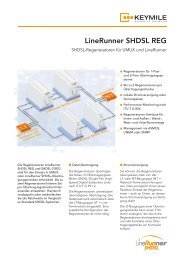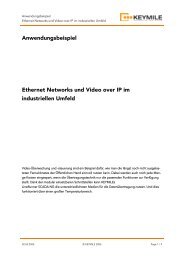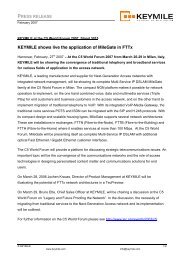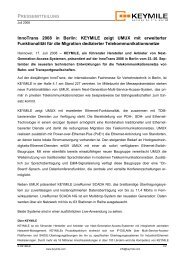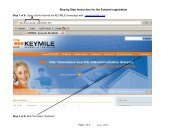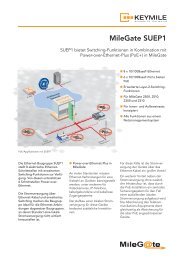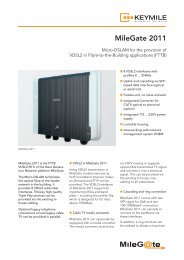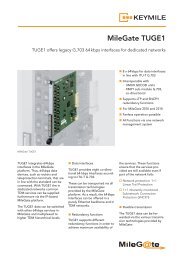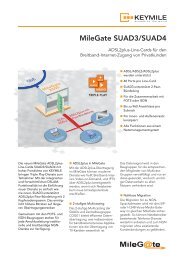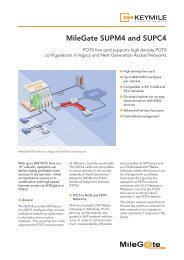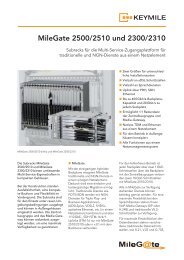White Paper Voice Services with IP-MSAN - KEYMILE
White Paper Voice Services with IP-MSAN - KEYMILE
White Paper Voice Services with IP-MSAN - KEYMILE
- TAGS
- keymile
- www.keymile.com
You also want an ePaper? Increase the reach of your titles
YUMPU automatically turns print PDFs into web optimized ePapers that Google loves.
<strong>White</strong> <strong>Paper</strong><br />
Advantages of <strong>Voice</strong>-over-<strong>IP</strong> <strong>with</strong> <strong>IP</strong>-based multi-service<br />
access nodes (<strong>IP</strong>-<strong>MSAN</strong>)<br />
2009-02-26 © <strong>KEYMILE</strong> 2009
<strong>White</strong> <strong>Paper</strong><br />
<strong>Voice</strong>-over-<strong>IP</strong> <strong>with</strong> an <strong>IP</strong>-<strong>MSAN</strong><br />
2009-02-26 © <strong>KEYMILE</strong> 2009 Page 2
<strong>White</strong> <strong>Paper</strong><br />
<strong>Voice</strong>-over-<strong>IP</strong> <strong>with</strong> an <strong>IP</strong>-<strong>MSAN</strong><br />
Table of content<br />
1 Abstract 4<br />
2 Operative advantages due to carrier-class properties 4<br />
3 An <strong>IP</strong>-<strong>MSAN</strong>’s telephony service 8<br />
3.1 Telephony solutions for private households and SOHO 8<br />
3.2 Telephony solutions for small to medium-sized enterprises (SMEs) 10<br />
3.3 Telephony solutions for large enterprises (LEs) 11<br />
3.4 Access technology for hosted PBX solutions 12<br />
4 Summary and perspectives 14<br />
2009-02-26 © <strong>KEYMILE</strong> 2009 Page 3
<strong>White</strong> <strong>Paper</strong><br />
<strong>Voice</strong>-over-<strong>IP</strong> <strong>with</strong> an <strong>IP</strong>-<strong>MSAN</strong><br />
1 Abstract<br />
This paper aims to explain to public network<br />
operators the applications and new functions,<br />
enabled by an <strong>IP</strong>-based multi-service access<br />
platform for telephony services. The white<br />
paper offers both technical and business<br />
arguments in favour of multi-service access<br />
networks, examines some applications and<br />
Native<br />
Vo<strong>IP</strong><br />
Ethernet<br />
Ethernet<br />
Vo<strong>IP</strong> +<br />
legacy<br />
Telephony<br />
SUBSCRIBER<br />
NETWORKS<br />
DSL NT<br />
Power Connect<br />
Ethernet<br />
LAN WAN<br />
POTS<br />
ISDN<br />
IAD<br />
1:05:13<br />
05 03 PLAY<br />
legacy<br />
Interconnect<br />
><br />
ARD<br />
SPORT<br />
KANAL 15 MI 8:12:59<br />
DSLAM<br />
Figure 1: Overview of the <strong>IP</strong>-<strong>MSAN</strong> functionality<br />
ON<br />
OFF<br />
replaces<br />
acts as<br />
POTS/ISDN<br />
When procuring network technology in public<br />
networks, operators have two major sets of<br />
expenses to deal <strong>with</strong>: the purchasing price of<br />
the solution (capital expenses, CAPEX) and the<br />
running costs (operational expenses, OPEX.)<br />
Usually, CAPEX is relatively easy to identify and<br />
to compare, OPEX is not. The reason lies in the<br />
effects of using different solutions that are<br />
often not predictable beforehand.<br />
A term often used by systems manufacturers is<br />
the expression carrier class. It signifi es product<br />
properties that are specifi cally required in<br />
public networks. If network technology only<br />
fulfi ls a few carrier class aspects, it is often<br />
affordably priced, however high follow-up costs<br />
can occur. When using <strong>IP</strong>-<strong>MSAN</strong>s which are<br />
usually applied in triple-play environments as<br />
access solutions, it is wise to ensure they have<br />
the following carrier class properties:<br />
<strong>IP</strong>-<strong>MSAN</strong><br />
looks at the past and future of <strong>IP</strong>-<strong>MSAN</strong><br />
technology. We have merely scratched the<br />
surface of other applications, such as <strong>IP</strong>TV,<br />
broadband DSL or fi bre-to-the-home (FTTH)<br />
that can be implemented <strong>with</strong> an <strong>IP</strong>-<strong>MSAN</strong>, as<br />
they have been explored in other publications.<br />
replaces<br />
PACKET<br />
CORE<br />
acts as<br />
2009-02-26 © <strong>KEYMILE</strong> 2009 Page 4<br />
DLC<br />
Vo<strong>IP</strong> Gateway<br />
ACCESS<br />
2 Operative advantages due to carrier-class properties<br />
Local Exchange<br />
PSTN<br />
BACKBONE<br />
■ Tough ambient conditions:<br />
An <strong>IP</strong>-<strong>MSAN</strong> is often used in air-conditioned<br />
and almost dust-free rooms, but must also be<br />
tough enough to function perfectly in a<br />
demanding, harsh environment, such as<br />
outdoor housings. Even in mild climates,<br />
when the sun shines directly on the housings,<br />
they reach an operating temperature of over<br />
50 °C. In this environment, it is even more<br />
important that resistance to vibrations and<br />
humidity are higher than in air-conditioned<br />
surroundings.<br />
■ Reliability and stability:<br />
all important components in the access<br />
solution (power unit, central card, gateway<br />
etc) that are vital for maintaining operation,<br />
should be designed so that they are redundant.<br />
The uplink connection should be<br />
redundant via two or more optical gigabit
<strong>White</strong> <strong>Paper</strong><br />
<strong>Voice</strong>-over-<strong>IP</strong> <strong>with</strong> an <strong>IP</strong>-<strong>MSAN</strong><br />
Ethernet links <strong>with</strong> automatic switching,<br />
should the call server (softswitch) or one of<br />
the paths fail because there is a malfunction<br />
in the line. It must be viable to carry out<br />
software and fi rmware updates while systems<br />
are operating and to monitor operating<br />
conditions using central sensors and alarms.<br />
■ Providing traditional telephony interfaces<br />
An <strong>IP</strong>-<strong>MSAN</strong> supplies the subscriber <strong>with</strong><br />
POTS and the ISDN interfaces, terminates<br />
them and in the network turns them into<br />
more cost effi cient <strong>Voice</strong>-over-<strong>IP</strong> technology<br />
(Vo<strong>IP</strong>.) The advantage is that end users can<br />
continue to utilise their traditional terminal<br />
equipment and the operator saves substantial<br />
running costs because no TDM is<br />
required (see the following chapters).<br />
■ Using extremely long copper access lines:<br />
Modern <strong>IP</strong>-<strong>MSAN</strong>s can implement symmetrical<br />
2 Mbps connections over copper lines<br />
that are 7 km long. In ISDN connections the<br />
lines can be over 10 km, in POTS over 20 km<br />
long.<br />
■ Service quality:<br />
When using advanced prioritising, fi ltering<br />
and queuing methods, voice, data and video<br />
signals in differing quality can be transmitted<br />
gradually to ensure end customers obtain the<br />
best service quality.<br />
■ Central network management <strong>with</strong> measurement<br />
functions:<br />
An access network, implemented <strong>with</strong><br />
<strong>IP</strong>-<strong>MSAN</strong>s, is operated centrally by a network<br />
management system. This provides the full<br />
set of management functions for FCAPS<br />
(fault, confi guration, alarm, performance and<br />
security.) The management system should be<br />
intuitive to operate and have a graphical<br />
interface. However, there should be a command-line<br />
interface (CLI) to guarantee<br />
integration into an existing CLI if required. It<br />
should also be possible to trigger measurement<br />
functions from a central operating<br />
location in order for example to prepare a<br />
copper access line <strong>with</strong>out time-consuming<br />
work on site.<br />
■ Flexibility:<br />
an <strong>IP</strong>-<strong>MSAN</strong> concept should allow for different<br />
chassis sizes for carrier class applications,<br />
so that usage is possible in different installation<br />
environments, i.e. indoor/outdoor,<br />
locally where the customer is situated etc. It<br />
should be possible to put the same cards in<br />
all chassis to enhance logistics and storage<br />
processes.<br />
■ Support of various transmission media:<br />
An <strong>IP</strong>-<strong>MSAN</strong> platform should support both<br />
copper wire and fi bre optic transmission,<br />
because nowadays almost all networks are<br />
designed heterogeneously. This allows the<br />
operator pervasive use of a single <strong>IP</strong>-<strong>MSAN</strong><br />
platform in different network architectures,<br />
such as fi bre-to-the-exchange (FTTE,) fi breto-the-curb<br />
(FTTC,) fi bre-to-the-building<br />
(FTTB,) or fi bre-to-the-home (FTTH) - as the<br />
picture shows.<br />
■ Supporting migration:<br />
When launching a new access platform it is<br />
not absolutely vital to port all traditional TDM<br />
services to packet-based ones. However, it<br />
must remain viable in the future as well to<br />
supply the full range of profi table services,<br />
responsible for generating most of the<br />
revenue and profi ts. In the fi xed line network,<br />
such services are for example POTS and<br />
ISDN telephony services, as well as the<br />
2 Mbps standard fi xed line network connection,<br />
so that private branch exchanges can be<br />
connected for example. These services<br />
should also be available in an <strong>IP</strong>-based<br />
access network.<br />
2009-02-26 © <strong>KEYMILE</strong> 2009 Page 5
<strong>White</strong> <strong>Paper</strong><br />
<strong>Voice</strong>-over-<strong>IP</strong> <strong>with</strong> an <strong>IP</strong>-<strong>MSAN</strong><br />
V– V+ P– P+<br />
V– V+ P– P+<br />
RG<br />
■ Product continuity and support:<br />
This entails providing software updates, regular<br />
new functions, including full release<br />
documentation and long-term provision of<br />
spare parts etc.<br />
■ Ethernet OAM (Operation, Administration<br />
and Maintenance):<br />
As Ethernet was originally not designed for<br />
operation in public networks, various<br />
attributes were missing initially that are<br />
required to achieve similar levels of operational<br />
reliability and manageability to SDH<br />
networks. As a result, several Ethernet OAM<br />
standards have been developed to introduce<br />
end-to-end monitoring and full management<br />
at several logical levels of an all-<strong>IP</strong> network. It<br />
should be easy to integrate an <strong>IP</strong>-<strong>MSAN</strong><br />
concept in this type of environment.<br />
■ Pay-as-you-grow access platform concept:<br />
in addition to the technical specifi cations, it is<br />
important not to forget the business side.<br />
The disadvantage of previous multi-service<br />
concepts was that the majority of the functions<br />
were integrated on the network ele-<br />
NT<br />
VDSL2<br />
ADSL2plus<br />
POTS<br />
ISDN<br />
ONT<br />
/RG<br />
FTTC: in street cabinets<br />
100BaseFX<br />
FTTH: Fibre to all subscribers<br />
FTTE and FTTH for<br />
residential and<br />
business customers<br />
Paket-based<br />
Access Network<br />
Gigabit<br />
Ethernet<br />
SHDSL.bis<br />
<strong>with</strong><br />
Pair Bonding<br />
100BaseFX<br />
POTS/ISDN<br />
VDSL2/ADSL2plus<br />
ment’s central card. There was no scalability<br />
in smaller sites because chassis types were<br />
not available, or joint usage of plug-in cards<br />
was not possible. The result was relatively<br />
high outlay at the beginning. Above all at the<br />
start of the rollout, operators might have<br />
thought that they were being asked to pay in<br />
advance for extended functions that they<br />
would only need to years later (if at all.)<br />
It should be possible to scale a modern<br />
<strong>IP</strong>-<strong>MSAN</strong> concept for small and large numbers<br />
of subscribers so that it makes commercial<br />
sense. A pay-as-you-grow effect in the<br />
access node is for example often implemented<br />
by including the functions primarily<br />
in the subscriber subracks. As a result, the<br />
operator only pays when new subscribers are<br />
connected and therefore new revenue<br />
generated. The chassis sizes and central<br />
cards of an <strong>IP</strong>-<strong>MSAN</strong> should be adjusted to<br />
handle small numbers of subscribers and also<br />
for very large POPs (points of presence) <strong>with</strong><br />
several thousand subscribers, in order to<br />
guarantee commercial success <strong>with</strong> the right<br />
port density.<br />
2009-02-26 © <strong>KEYMILE</strong> 2009 Page 6<br />
Metro<br />
Node<br />
FTTB for large Enterprise<br />
or Unitversity site<br />
V– V+ P– P+<br />
VDSL2<br />
Figure 2: Multi-service does not just mean providing the most important service interfaces, but also the fl exibility to be able,<br />
cost effectively, to use an <strong>IP</strong>-<strong>MSAN</strong> in various network scenarios.
<strong>White</strong> <strong>Paper</strong><br />
<strong>Voice</strong>-over-<strong>IP</strong> <strong>with</strong> an <strong>IP</strong>-<strong>MSAN</strong><br />
Network operators should check all these<br />
carrier class attributes very carefully, so that the<br />
business case is not rendered obsolete after<br />
selecting the system because of the operating<br />
costs. If operators want to optimise CAPEX,<br />
they can consider opting for an access solution<br />
that fulfi ls fewer quality attributes than a carrier<br />
class <strong>IP</strong>-<strong>MSAN</strong>. However, they should be aware<br />
of potential repercussions: OPEX follow-on<br />
costs, incurred as a result of troubleshooting,<br />
network downtimes and damage to image, are<br />
usually much higher. In this case, it is important<br />
to make a cost-effi cient and future proof<br />
decision.<br />
2009-02-26 © <strong>KEYMILE</strong> 2009 Page 7
<strong>White</strong> <strong>Paper</strong><br />
<strong>Voice</strong>-over-<strong>IP</strong> <strong>with</strong> an <strong>IP</strong>-<strong>MSAN</strong><br />
3 An <strong>IP</strong>-<strong>MSAN</strong>’s telephony service<br />
The chief aim of an <strong>IP</strong>-<strong>MSAN</strong> is to integrate all<br />
commonly-available groups of services in the<br />
fi xed line network, i. e. voice, data and video<br />
and provide their services. We will now look at<br />
telephony in more detail. On the one hand<br />
because today the majority of sales are<br />
achieved <strong>with</strong> the standard telephony services<br />
and on the other, because of the potential for<br />
improvement in public networks. This is the<br />
area where operators need to take action.<br />
In the voice exchange, many operators nowadays<br />
still use 64 kbit TDM technology. Use of<br />
the technology will continue in many areas for<br />
some time to come, due to the high level of<br />
investment and long periods of depreciation.<br />
As a result, in addition to state-of-the-art<br />
<strong>Voice</strong>-over-<strong>IP</strong> technology, modern <strong>IP</strong>-<strong>MSAN</strong><br />
platforms will have to continue to use TDM<br />
interfaces – whether towards the subscribers, or<br />
to the exchange.<br />
As the name <strong>IP</strong>-<strong>MSAN</strong> already suggests, this<br />
category of access solutions also includes <strong>IP</strong><br />
functionality. Important are Vo<strong>IP</strong>-gateway<br />
functions that convert POTS and ISDN subscriber<br />
interfaces into RTP (Real Time Transport<br />
Protocol) Ethernet packages and exercise<br />
control <strong>with</strong> H.248/MEGACO or S<strong>IP</strong>-signalling<br />
via a soft switch or call server. This sophisticated<br />
type of telephony saves substantial<br />
network operating costs, as Ethernet transmission<br />
technology is used and the traditional<br />
digital exchanges can be replaced by just a few<br />
soft switches. As far as subscribers are concerned,<br />
the same familiar services (i.e. POTS or<br />
ISDN) are implemented that the customer<br />
recognises from TDM technology. Ideally,<br />
subscribers will notice no difference after<br />
network conversion from TDM to <strong>IP</strong> and can<br />
continue to use their favourite terminal equipment<br />
(like DECT telephones, ISDN private<br />
exchanges, fax machines etc) <strong>with</strong>out any<br />
problems.<br />
However, many network operators have not,<br />
even today, migrated their TDM voice network<br />
entirely to Vo<strong>IP</strong> technology. There are many<br />
reasons for this. To supply these providers <strong>with</strong><br />
problem-free access to modern NGN technol-<br />
ogy, advanced <strong>IP</strong>-<strong>MSAN</strong> concepts use a hybrid<br />
backplane architecture, which can also provide<br />
POTS and ISDN subscriber interfaces traditionally<br />
via a V5.2 uplink. The TDM interfaces use<br />
the TDM backplane in this architecture and the<br />
packet-driven interface boards the Ethernet<br />
backplane. Therefore, both TDM and Ethernet<br />
technology can be used <strong>with</strong>out complex<br />
emulation technology. With hybrid boards that<br />
can access both backplanes, migration scenarios<br />
can be implemented easily and effi ciently<br />
– <strong>with</strong>out exchanging existing hardware. This<br />
option protects both the operators’ investment<br />
and allows them to seamlessly migrate to the<br />
convergent All-<strong>IP</strong> world.<br />
Migration scenarios such as these will be<br />
outlined in more detail in another <strong>KEYMILE</strong><br />
white paper. The rest of this paper will concentrate<br />
on operation scenarios where a Vo<strong>IP</strong> voice<br />
exchange (soft switch, call server etc) is already<br />
used exclusively.<br />
3.1 Telephony solutions for private<br />
households and SOHO<br />
Basically the demands of private households<br />
and the small offi ce/home offi ce (SOHO) as<br />
regards telephony services are similar. Residential<br />
properties these days usually still have<br />
POTS, but in the business segment, ISDN tends<br />
to be more popular because of the extra<br />
attributes it can offer.<br />
Nowadays, both technologies are experiencing<br />
increasing competition due to <strong>Voice</strong>-over-Internet<br />
and <strong>Voice</strong>-over-DSL (VoDSL) because these<br />
services are usually cheaper, or in some cases<br />
even free of charge (see fi gure 2, case A.) In<br />
some cases they provide more functions than<br />
traditional telephony (e.g. <strong>with</strong> several telephone<br />
lines via one single copper line, video<br />
telephony etc.)<br />
Nevertheless, in the future it will continue to be<br />
essential that network operators offer POTS<br />
and ISDN interfaces via copper lines in the<br />
private customer environment: (see Figure 3 at<br />
page 9, case C.):<br />
2009-02-26 © <strong>KEYMILE</strong> 2009 Page 8
<strong>White</strong> <strong>Paper</strong><br />
<strong>Voice</strong>-over-<strong>IP</strong> <strong>with</strong> an <strong>IP</strong>-<strong>MSAN</strong><br />
Broadband<br />
Subscriber<br />
(voice +<br />
DSL or Fibre)<br />
Soft<br />
Client<br />
Ethernet<br />
Vo<strong>IP</strong><br />
Broadband<br />
Subscriber<br />
(voice + DSL)<br />
■ Legal stipulations:<br />
The POTS connection is one of the primary<br />
services that must be provided.<br />
■ Budget stipulations in extending networks:<br />
POTS and ISDN ports in the <strong>IP</strong>-<strong>MSAN</strong> are<br />
more affordable than DSL ports.<br />
■ Using existing exchange technology:<br />
The existing TDM exchanges will continue to<br />
be used.<br />
■ Very long copper paths:<br />
The maximum length of ADSL paths is<br />
approximately 7 km. Particularly in rural<br />
regions however, lines of more than 10 km<br />
are standard.<br />
■ Life line service:<br />
In the case of telephone connections that<br />
need to be extremely reliable (emergency<br />
telephones, doctors, police stations, fi re<br />
alarms, other alarms etc), VoDSL or even<br />
<strong>Voice</strong>-over-Internet is no alternative because<br />
the network terminations or telephones have<br />
to be supplied locally. The risk of malfunction<br />
(e. g. the power supply unit breaks) is too<br />
high in these cases - remote supply is absolutely<br />
vital.<br />
Power Connect<br />
NT<br />
Customer A<br />
LAN WAN<br />
1:05:13<br />
05 03 PLAY<br />
IAD<br />
Telephony<br />
Subscriber<br />
(voice only)<br />
><br />
ARD<br />
SPORT<br />
KANAL 15 MI 8:12:59<br />
POTS/ISDN<br />
Customer B<br />
ON<br />
OFF<br />
<strong>IP</strong>-<strong>MSAN</strong><br />
POTS/ISDN<br />
Customer C<br />
SUBSCRIBER<br />
Packet<br />
Core<br />
Softswitch<br />
ACCESS BACKBONE<br />
With <strong>IP</strong>-<strong>MSAN</strong>s, network operators can even<br />
apply the more attractive Vo<strong>IP</strong> technology in<br />
the network for these diffi cult cases to save<br />
costs and use a homogenous all-<strong>IP</strong> network<br />
infrastructure in the network internally. The<br />
POTS and ISDN signals are terminated by the<br />
Vo<strong>IP</strong> gateway in the <strong>IP</strong>-<strong>MSAN</strong>, turned into S<strong>IP</strong><br />
or H.248/MEGACO signals and conveyed as <strong>IP</strong><br />
packets through the backbone network.<br />
Advantages for the network operator:<br />
■ The backbone can be completely switched to<br />
Ethernet.<br />
■ SDH backbone technology, <strong>with</strong> its ineffi cient<br />
use of bandwidths, can be switched off.<br />
■ TDM exchange technology can be replaced<br />
by more powerful and affordable soft switch<br />
technology.<br />
■ Operating costs are reduced signifi cantly.<br />
■ The end customers do not notice the switch;<br />
they can continue to use their previous<br />
terminal equipment. This reduces the churn<br />
rate.<br />
■ Due to the lower operating costs, competitive<br />
products <strong>with</strong> the same margin can be<br />
achieved.<br />
2009-02-26 © <strong>KEYMILE</strong> 2009 Page 9<br />
PSTN<br />
TDM route<br />
Vo<strong>IP</strong> route<br />
Figure 3: An <strong>IP</strong>-<strong>MSAN</strong> platform provides POTS, ISDN and Vo<strong>IP</strong> telephony in one platform and turns them <strong>with</strong>in the network into cost<br />
effi cient Vo<strong>IP</strong> technology.
<strong>White</strong> <strong>Paper</strong><br />
<strong>Voice</strong>-over-<strong>IP</strong> <strong>with</strong> an <strong>IP</strong>-<strong>MSAN</strong><br />
3.2 Telephony solutions for small to<br />
medium-sized enterprises (SMEs)<br />
TDM<br />
PBX<br />
ISDN-PRA<br />
SME Subsidiary A<br />
SME Subsidiary B<br />
<strong>IP</strong>-<strong>MSAN</strong><br />
TDM<br />
PBX<br />
GbE<br />
ISDN-PRA<br />
Metro<br />
Node<br />
Option 3: Tunneling of<br />
2 Mbps stream through<br />
the packet backbone<br />
using CESoP transparently<br />
SUBSCRIBER<br />
<strong>IP</strong>-<strong>MSAN</strong><br />
Figure 4: Network connection of two sites belonging to an SME <strong>with</strong> a private exchange<br />
Many SMEs have a TDM private exchange that<br />
is connected to the public network <strong>with</strong> n x 2<br />
Mbps interfaces. Although nowadays modern<br />
Vo<strong>IP</strong> based private exchanges already exist,<br />
there are good reasons why many SMEs still<br />
stick to the existing system. As a result, when<br />
planning the network, it is advisable to consider<br />
what the demands will be over the next<br />
few years.<br />
In TDM networks, the TDM private exchange<br />
was terminated at the exchange or transmitted<br />
transparently to other places where the company<br />
is located. As Figure 4 at page 10 shows,<br />
modern <strong>IP</strong>-<strong>MSAN</strong>s must provide several<br />
transmission alternatives.<br />
Description<br />
Option 1<br />
Advantage Disadvantage<br />
Termination of ■ There is no ■ Vo<strong>IP</strong> gateway<br />
the ISDN-PRA TDM in the functions<br />
signalling and core network. necessary in<br />
implementation<br />
into Vo<strong>IP</strong><br />
signalling (S<strong>IP</strong><br />
or H.248) in the<br />
<strong>IP</strong>-<strong>MSAN</strong>. In the<br />
core network, a<br />
telephone connection<br />
is entirely<br />
<strong>IP</strong>-based, the<br />
payload data is<br />
routed.<br />
■ Less complexity.<br />
■ Better usage of<br />
the bandwidths<br />
in the core<br />
network.<br />
each access<br />
node.<br />
Softswitch<br />
Vo<strong>IP</strong> via H.248/S<strong>IP</strong><br />
ACCESS<br />
other<br />
Networks<br />
Option 1: Decentralized<br />
termination of ISDN-PRA<br />
signalling and conversion<br />
into Vo<strong>IP</strong> <strong>with</strong>in the <strong>IP</strong>-<strong>MSAN</strong><br />
PACKET<br />
BACKBONE<br />
2009-02-26 © <strong>KEYMILE</strong> 2009 Page 10<br />
Metro<br />
Node<br />
ISDN PRA<br />
<strong>Voice</strong> GW<br />
GbE<br />
Option 2: Tunneling of 2 Mbps<br />
stream through the packet backbone<br />
and centralized termination<br />
of ISDN-PRA signaling at a<br />
Vo<strong>IP</strong> Gateway (GW)<br />
Description<br />
Option 2:<br />
Advantage Disadvantage<br />
Transparent ■ Only one or a ■ CESoP<br />
tunnelling of few ISDN-PRA- gateway<br />
the ISDN-PRA gateway(s) are functions<br />
signalling via required in the necessary in<br />
Circuit-Emulation exchange. each access<br />
(CESoP). Telephony<br />
signalling is<br />
only terminated<br />
in a dedicated<br />
ISDN-PRA gateway<br />
centrally and<br />
implemented in<br />
Vo<strong>IP</strong>.<br />
Option 3<br />
■ In addition to<br />
ISDN-PRA,<br />
synchronised<br />
2 Mbps TDM<br />
connections<br />
can also be<br />
carried put via<br />
CESoP.)<br />
node.<br />
■ The bandwidth<br />
for TDM<br />
emulation must<br />
be reserved in<br />
the core<br />
network.<br />
Transparent ■ See option 2 ■ See option 2<br />
tunnelling of<br />
the ISDN-PRA<br />
signalling via<br />
Circuit-Emulation<br />
(CESoP) to<br />
another PBX at<br />
another of the<br />
company’s locations.<br />
Telephony<br />
signalling is not<br />
considered.<br />
■ If several of the<br />
customer’s<br />
premises are<br />
located on the<br />
same<br />
<strong>IP</strong>-<strong>MSAN</strong>, no<br />
data traffi c has<br />
to take place<br />
on the core<br />
network at all.
<strong>White</strong> <strong>Paper</strong><br />
<strong>Voice</strong>-over-<strong>IP</strong> <strong>with</strong> an <strong>IP</strong>-<strong>MSAN</strong><br />
3.3 Telephony solutions for large<br />
enterprises (LEs)<br />
Customer<br />
Location A<br />
Customer<br />
Location B<br />
Private LAN<br />
<strong>with</strong> TLS<br />
PC<br />
n x VDSL2<br />
Customer<br />
Location C<br />
n x VDSL2<br />
100BaseFX<br />
Power Connect<br />
LAN WAN<br />
VDSL2<br />
<strong>IP</strong>-<strong>MSAN</strong><br />
ISDN<br />
PC<br />
<strong>IP</strong>-<strong>MSAN</strong><br />
POTS<br />
100BaseT<br />
2009-02-26 © <strong>KEYMILE</strong> 2009 Page 11<br />
GbE<br />
<strong>IP</strong>-<strong>MSAN</strong><br />
GbE<br />
<strong>IP</strong>-<strong>MSAN</strong><br />
TLS<br />
Central Office<br />
GbE<br />
CUSTOMER<br />
Figure 5: Example of a telecommunications network in a large enterprise in three different places<br />
Figure 5 at page 11 shows an example of a<br />
network in a large enterprise in three different<br />
locations. There are very rarely ready-made<br />
network solutions for these types of applications,<br />
so customised solutions are nearly always<br />
required. Therefore it is advisable for public<br />
network operators to use the most fl exible<br />
platform possible as CPE equipment that does<br />
not just support one or two services. The CPE<br />
solution must also be as fl exible as possible,<br />
and as the fi gure shows, able to be installed in<br />
outdoor housings too, provide remote testing<br />
and measurement functions, support copper<br />
and fi bre optic connections – or in other words<br />
have carrier class quality.<br />
The following subscriber interfaces are required<br />
on a large company’s premises:<br />
■ POTS/ISDN: as a substitute for private<br />
exchanges (see following chapter.)<br />
■ ADSL2plus: to connect remote places of<br />
work, or remote measurement or monitoring<br />
functions, for example video cameras.<br />
ACCESS<br />
Packet<br />
Backbone<br />
■ E1/G.703: to connect 64 kbps or 2 Mbps<br />
TDM equipment such as private exchanges,<br />
sensors, monitoring technology etc via<br />
copper wire.<br />
■ SHDSL: such as E1/G.703, only for long, lines<br />
of 100 m to 8 km.<br />
■ 100BaseTx: To connect 100 Mbps LAN<br />
segments, servers or other IT components via<br />
Ethernet in-house cabling.<br />
■ VDSL2: such as 100BaseTx, but only for<br />
applications where standard Ethernet cabling<br />
is not suffi cient because of the distance or<br />
the interference.<br />
■ 100BaseFx: like 100BaseTx, but <strong>with</strong> a fi bre<br />
optic interface.<br />
■ 1000BaseFx: like 100BaseTx, but <strong>with</strong><br />
maximum bandwidth of 1 Gbps.
<strong>White</strong> <strong>Paper</strong><br />
<strong>Voice</strong>-over-<strong>IP</strong> <strong>with</strong> an <strong>IP</strong>-<strong>MSAN</strong><br />
3.4 Access technology for hosted PBX<br />
solutions<br />
Hosted-PBX Site A<br />
Soft<br />
Client<br />
Figure 6: Advantages of using an <strong>IP</strong>-<strong>MSAN</strong> in hosted PBX applications<br />
The defi nition of hosted PBX is that the functions<br />
of a private exchange are moved to the<br />
public network and are supplied by the service<br />
provider via a broadband connection. Technically<br />
this is usually implemented by an <strong>IP</strong>-Centrex<br />
application that is either integrated in the<br />
soft switch or operated on an application<br />
server.<br />
RG<br />
POTS<br />
Hosted-PBX Site B<br />
ISDN<br />
supporting copper<br />
lines >10 km<br />
ADSL2plus, SHDSL<br />
VDSL2, 100BaseFX<br />
TDM<br />
PBX<br />
Hosted-PBX Site C<br />
ISDN Fallback Line<br />
replace<br />
<strong>IP</strong>-<strong>MSAN</strong><br />
LARGE<br />
DISTRIBUTED<br />
ENTERPRISES<br />
ACCESS<br />
The advantage of this business model to<br />
corporate customers is that no specially trained<br />
personnel is required. Another benefi t is the<br />
fact that no investments need to be made in<br />
technology (PBX) and the communications<br />
costs are transferred from CAPEX to OPEX. The<br />
end customer can also enjoy new services that<br />
previously did not exist because they were too<br />
expensive or too complicated to execute. The<br />
following table shows some examples.<br />
2009-02-26 © <strong>KEYMILE</strong> 2009 Page 12<br />
<strong>IP</strong>-<strong>MSAN</strong><br />
GbE<br />
Metro<br />
Ethernet<br />
<strong>IP</strong>-Centrex<br />
RS-232<br />
1<br />
2<br />
3<br />
4<br />
other <strong>IP</strong>-Centrex<br />
Applications Server<br />
ETH<br />
GbE<br />
Hosted PBX-<br />
Environment in<br />
the Central Office<br />
BACKBONE
<strong>White</strong> <strong>Paper</strong><br />
<strong>Voice</strong>-over-<strong>IP</strong> <strong>with</strong> an <strong>IP</strong>-<strong>MSAN</strong><br />
Examples and possible impact of hosted PBX applications<br />
New services Impact Advantage<br />
Using new media and ■ The PCs or the laptop replaced the<br />
■ Reduction in costs for terminal equipment<br />
terminal equipment<br />
for communications<br />
traditional hardware telephone using the<br />
Vo<strong>IP</strong> soft client.<br />
■ Employee fl exibility increased<br />
purposes<br />
■ The mobile phone plus Vo<strong>IP</strong> client serves as<br />
terminal equipment and uses a WiFi<br />
connection.<br />
Job mobility increased<br />
in the company<br />
Connecting the <strong>IP</strong>-<br />
Centrex service <strong>with</strong><br />
Offi ce applications<br />
As soon as a subscriber logs into the company<br />
LAN or WAN, whether it is from one of<br />
the company premises or remotely via a VPN<br />
connection, the employee can be reached<br />
worldwide under his extension number.<br />
■ Presence function: Other employees in a<br />
buddy list can see what the current present<br />
status of the employees is (for example<br />
logged in, absent, temporarily absent etc.)<br />
■ Additional communications functions such as<br />
voice/video mailbox as an e-mail attachment,<br />
instant messaging, white boarding, application<br />
sharing, conferencing etc.<br />
Reliability An <strong>IP</strong>-Centrex solution based on carrier class<br />
technology that was designed for use in public<br />
networks.<br />
As regards the implementation of hosted PBX<br />
applications in the public network, all of the<br />
previously mentioned customer applications<br />
and switching scenarios from the previous<br />
chapters can be applied. The key advantages<br />
of integrating an <strong>IP</strong>-<strong>MSAN</strong> into such applications<br />
are:<br />
■ Integration of traditional POTS and ISDN<br />
connections into <strong>IP</strong>-Centrex groups (see<br />
Figure 5 at page 11, site A): previously, a major<br />
problem posed by corporate-wide hosted<br />
PBX solutions was that it was not possible to<br />
operate a mixture of the TDM and Vo<strong>IP</strong><br />
terminal points easily in a single Centrex<br />
group. As the <strong>IP</strong>-<strong>MSAN</strong> makes the TDM<br />
subscriber interface towards an <strong>IP</strong>S Centrex<br />
application look like a Vo<strong>IP</strong> subscriber, the<br />
old problem of the mixed Centrex groups is<br />
solved.<br />
■ Discarding TDM private exchanges in the<br />
corporate network (see Figure 5 at page 11,<br />
site C): A major obstacle in launching a<br />
company-wide hosted PBX service was often<br />
the fact that customers did not want (for<br />
fi nancial reasons) or could not (for technical<br />
reasons) discard existing telephones or other<br />
terminal equipment.<br />
■ Employees can be reached on the phone more<br />
easily.<br />
■ Lower costs in comparison to mobile phone<br />
usage, above all abroad.<br />
■ Costs for offi ce moves are reduced (changing<br />
the cabling etc.)<br />
■ Increase in corporate productivity by raising the<br />
level of effi ciency of each individual employee.<br />
■ Improvement in team working, due to different<br />
conference functions that integrate offi ce and<br />
home workers.<br />
In comparison to private exchanges that require<br />
expensive and time-consuming servicing if<br />
hardware fails, an <strong>IP</strong>-Centrex solution is a lot more<br />
reliable. It is monitored and maintained centrally<br />
by the service provider and errors can be put right<br />
much more quickly.<br />
By using POTS and ISDN interface cards, an<br />
<strong>IP</strong>-<strong>MSAN</strong> can replace TDM private<br />
exchanges, existing terminal equipment can<br />
be retained and from the point of view of the<br />
network, TDM and Vo<strong>IP</strong> terminal equipment<br />
can be integrated into <strong>IP</strong> Centrex groups and<br />
therefore into the hosted PBX solution.<br />
■ Providing a broadband connection (copper<br />
and fi bre optics) including an ISDN fallback<br />
line for hosted PBX locations (see Figure 5 at<br />
page 11, site B): in addition to providing the<br />
broadband connection (DSL or optical<br />
Ethernet) for company premises, which is<br />
used to convey both data and the Vo<strong>IP</strong> voice<br />
traffi c from the <strong>IP</strong>-Centrex group, <strong>IP</strong>-<strong>MSAN</strong> in<br />
the fi xed network can provide one or several<br />
ISDN fall back lines. This connection<br />
becomes active if the broadband path fails<br />
and therefore guarantees company voice<br />
traffi c. From the point of view of the network,<br />
the ISDN fallback line is converted by<br />
the <strong>IP</strong>-<strong>MSAN</strong>s Vo<strong>IP</strong> gateway into Vo<strong>IP</strong><br />
signalling. This allows integration into the<br />
<strong>IP</strong>-Centrex solution.<br />
Both for the customer and the network<br />
operator, this method is a win-win situation:<br />
the customer enjoys the advantages of<br />
2009-02-26 © <strong>KEYMILE</strong> 2009 Page 13
<strong>White</strong> <strong>Paper</strong><br />
<strong>Voice</strong>-over-<strong>IP</strong> <strong>with</strong> an <strong>IP</strong>-<strong>MSAN</strong><br />
<strong>IP</strong>-Centrex, but also continues to reap the<br />
benefi ts of reliability from the familiar TDM<br />
world. The network operator can put the<br />
4 Summary and perspectives<br />
The outstanding success of Vo<strong>IP</strong> technology in<br />
public and private networks is unstoppable.<br />
Using carrier-class <strong>IP</strong>-<strong>MSAN</strong>s in the access<br />
networks exploits the advantages of two<br />
technological worlds. The <strong>IP</strong>-<strong>MSAN</strong> converts<br />
the existing POTS and ISDN connections into<br />
Vo<strong>IP</strong> and at the same time implements broadband<br />
All-<strong>IP</strong> connections via copper or fi bre<br />
optic lines. This allows operators to migrate<br />
their networks today already to more affordable,<br />
scaleable and future-proof Vo<strong>IP</strong> technology,<br />
<strong>with</strong>out compromising on quality. For<br />
implementing corporate network solutions,<br />
such as hosted PBX telephony, the carrier class<br />
design of the <strong>IP</strong>-<strong>MSAN</strong> platform is perfect.<br />
Good arguments can be made to counteract<br />
customer scepticism re safety, quality and<br />
stability. Without doubt, <strong>IP</strong> Centrex applications,<br />
combined <strong>with</strong> <strong>IP</strong>-<strong>MSAN</strong> technology, can<br />
be implemented at the same service level<br />
quality as is the case for TDM services. The<br />
difference is that the new technology has<br />
signifi cantly more benefi ts in terms of operation<br />
and usage. This is supported by Ethernet<br />
OAM standards, that (similarly to TDM traffi c<br />
networks) offer end-to-end management and<br />
therefore support carrier class quality in terms<br />
of network operation.<br />
During a network migration to IMS network<br />
architecture, setting up <strong>IP</strong>-<strong>MSAN</strong>s is an important<br />
and necessary step and ideally prepares<br />
the access network for future conversion to<br />
All-<strong>IP</strong>. Thanks to the ETSI TISPAN standard, in<br />
the future an IMS-Media Control Layer will be<br />
able to manage <strong>IP</strong>-<strong>MSAN</strong>s as full network<br />
elements.<br />
minds of critical customers at rest and still<br />
use 100 % more effi cient Vo<strong>IP</strong> technology in<br />
the network.<br />
Finally, we should mention that many network<br />
operators worldwide have already recognised<br />
the benefi ts of using an <strong>IP</strong>-<strong>MSAN</strong> and will<br />
completely convert their access networks to <strong>IP</strong><br />
technology in the next few years. From marketing<br />
and business standpoints, the potential to<br />
gain a competitive edge is extremely high. It is<br />
particularly important not to compromise when<br />
selecting the technology for the access network.<br />
Should the operator back the wrong<br />
horse when choosing the interface to the<br />
customer, the loss of image can be enormous.<br />
2009-02-26 © <strong>KEYMILE</strong> 2009 Page 14
<strong>White</strong> <strong>Paper</strong><br />
<strong>Voice</strong>-over-<strong>IP</strong> <strong>with</strong> an <strong>IP</strong>-<strong>MSAN</strong><br />
2009-02-26 © <strong>KEYMILE</strong> 2009 Page 15
<strong>White</strong> <strong>Paper</strong><br />
<strong>Voice</strong>-over-<strong>IP</strong> <strong>with</strong> an <strong>IP</strong>-<strong>MSAN</strong><br />
Author<br />
Marc Kahabka<br />
Product Support Switzerland<br />
Publisher<br />
<strong>KEYMILE</strong> GmbH<br />
Wohlenbergstraße 3<br />
30179 Hanover, Germany<br />
Phone +49 511 6747-0<br />
Fax +49 511 6747-450<br />
Internet www.keymile.com<br />
Mail info@keymile.com<br />
2009-02-26 © <strong>KEYMILE</strong> 2009 Page 16



